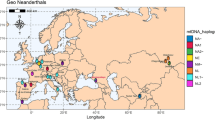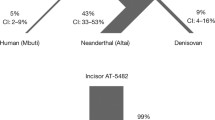Abstract
The expansion of premodern humans into western and eastern Europe ∼40,000 years before the present led to the eventual replacement of the Neanderthals by modern humans ∼28,000 years ago1. Here we report the second mitochondrial DNA (mtDNA) analysis of a Neanderthal, and the first such analysis on clearly dated Neanderthal remains. The specimen is from one of the eastern-most Neanderthal populations, recovered from Mezmaiskaya Cave in the northern Caucasus2. Radiocarbon dating estimated the specimen to be ∼29,000 years old and therefore from one of the latest living Neanderthals3. The sequence shows 3.48% divergence from the Feldhofer Neanderthal4. Phylogenetic analysis places the two Neanderthals from the Caucasus and western Germany together in a clade that is distinct from modern humans, suggesting that their mtDNA types have not contributed to the modern human mtDNA pool. Comparison with modern populations provides no evidence for the multiregional hypothesis of modern human evolution.



Similar content being viewed by others
References
Stringer, C. B. & Mackie, R. African Exodus: the Origin of Modern Humanity (Cape, London, 1996).
Golovanova, L. V., Hoffecker, J. F., Kharitonov, V. M. & Romanova, G. P. Mezmaiskaya Cave: A Neanderthal occupation in the Northern Caucasus. Curr. Anthropol. 40, 77–86 (1999).
Smith, F. H., Trinkaus, E., Pettitt, P. B., Karavanic, I. & Paunovic, M. Direct radiocarbon dates for Vindija G1 and Velika Pecina Late Pleistocene hominid remains. Proc. Natl Acad. Sci. USA 96, 12281–12286 (1999).
Krings, M. et al. Neandertal DNA sequence and the origin of modern humans. Cell 90, 19–30 ( 1997).
Krings, M., Geisert, H., Schmitz, R. W., Krainitzki, H. & Pääbo, S. DNA sequence of the mitochondrial hypervariable region II from the Neandertal type specimen. Proc. Natl Acad. Sci. USA 96, 5581–5585 (1999).
Cooper, A. et al. Neandertal genetics. Science 277, 1021–1023 (1997).
Gabunia, L. & Vekua, A. A Plio-Pleistocene hominid from Dmanisi, East Georgia, Caucasus. Nature 373, 509– 512 (1995).
Kozlowski, J. K. in Neandertals and Modern Humans in Western Asia 461– 482 (Plenum, New York–London, 1998).
Brown, T. A., Nelson, D. E., Vogel, J. S. & Southon, J. R. Improved collagen extraction by modified Longin method. Radiocarbon 30, 171–177 ( 1988).
DeNiro, M. J. Postmortem preservation and alteration of in vivo bone collagen isotope ratios in relation to palaeodietary reconstruction. Nature 317, 806–809 (1985).
Anderson, S. et al. Sequence and organisation of the human mitochondrial genome. Nature 290, 457–474 (1981).
Höss, M. et al. DNA damage and DNA sequence retrieval from ancient tissue. Nucleic Acids Res. 24, 1304– 1307 (1996).
Gagneux, P. et al. Mitochondrial sequences show diverse evolutionary histories of African hominoids. Proc. Natl Acad. Sci. USA 96, 5077–5082 (1999).
Gamble, C. in Prehistoric Europe 5–41 (Oxford Univ. Press, Oxford, 1998).
Lidén, K., Götherström, A. & Eriksson, E. Diet, gender and rank. ISKOS 11, 158–164 ( 1997).
Swofford, D. L. PAUP*: Phylogenetic Analysis Using Parsimony (* and Other Methods) Version 4. (Sinauer Associates, Sunderland, Massachusetts, 1998).
Tamura, K. & Nei, M. Estimation of the number of nucleotide substitutions in the control region of mitochondrial DNA in humans and chimpanzees. J. Mol. Evol. 10, 512– 526 (1993).
Excoffier, L. & Yang, Z. Substitution rate variation among sites in mitochondrial hypervariable region I of humans and chimpanzees. Mol. Biol. Evol. 16, 1357–1368 (1999).
Burckhardt, F., von Haeseler, A. & Meyer, S. HvrBase: compilation of mtDNA control region sequences from primates. Nucleic Acids Res. 27, 138 –142 (1999).
Acknowledgements
We are indebted to L. V. Golovanova for the excavations in Mezmaiskaya Cave that provided materials for analysis. We thank V. P. Ljubin and P. Vanezis for encouragement and support; B. L. Cohen for numerous discussions; J. L. Harley, O. I. Ovtchinnikova, E. B. Druzina and J. Wakefield for technical help and assistance; R. Page for help with the phylogenetic analysis; and P. Beerli, A. Cooper, M. Cusack, M. Nordborg and M. Ruvolo for useful comments. I.V.O. thanks his host G. Curry. I.V.O. was supported by a Royal Society/NATO Fellowship. We thank the Swedish Royal Academy of Sciences and the Swedish Research Council for Natural Sciences for partial financial support.
Author information
Authors and Affiliations
Corresponding author
Rights and permissions
About this article
Cite this article
Ovchinnikov, I., Götherström, A., Romanova, G. et al. Molecular analysis of Neanderthal DNA from the northern Caucasus. Nature 404, 490–493 (2000). https://doi.org/10.1038/35006625
Received:
Accepted:
Issue Date:
DOI: https://doi.org/10.1038/35006625
- Springer Nature Limited
This article is cited by
-
New perspectives on Neanderthal dispersal and turnover from Stajnia Cave (Poland)
Scientific Reports (2020)





